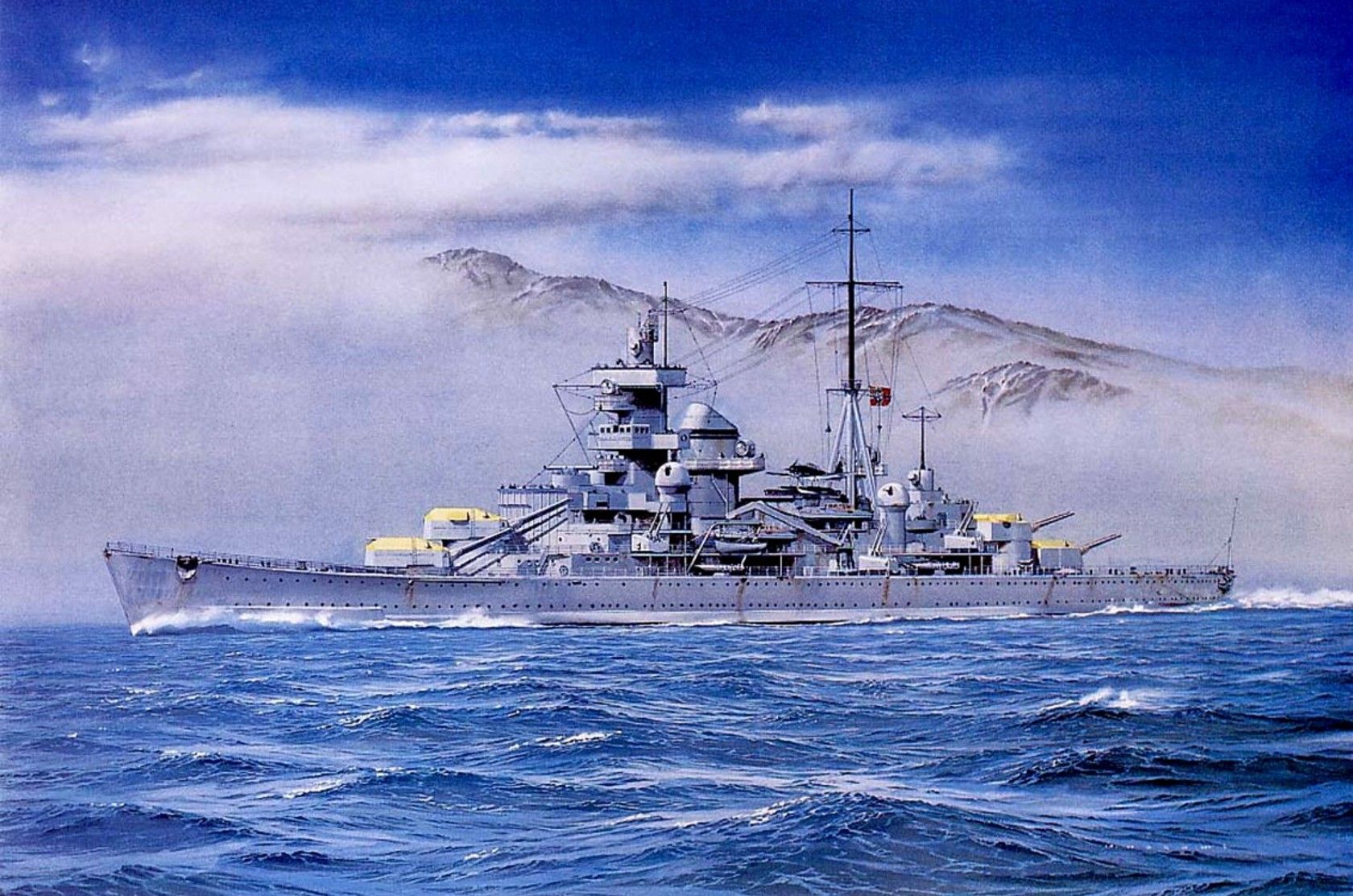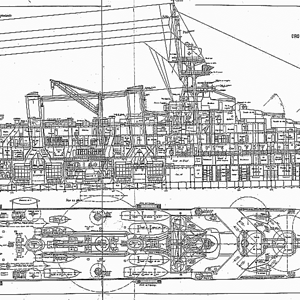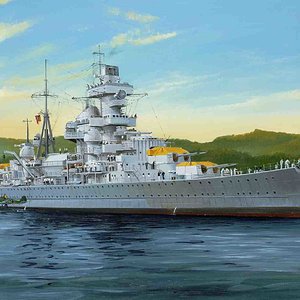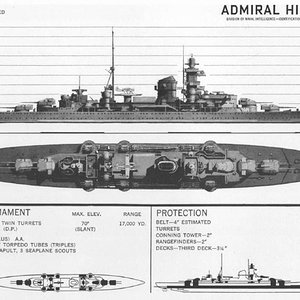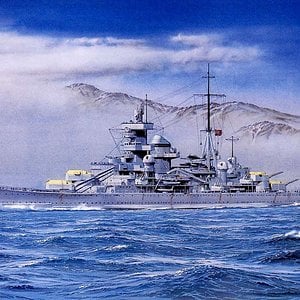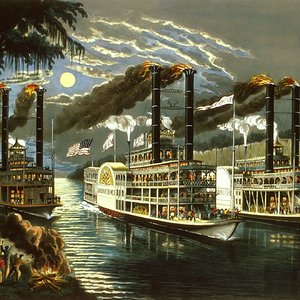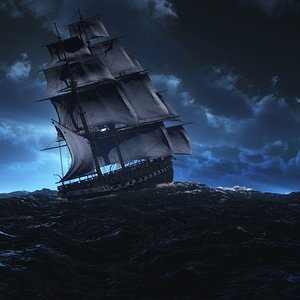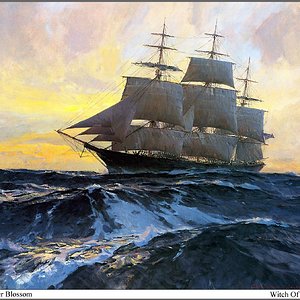Navigation
Install the app
How to install the app on iOS
Follow along with the video below to see how to install our site as a web app on your home screen.
Note: This feature may not be available in some browsers.
More options
You are using an out of date browser. It may not display this or other websites correctly.
You should upgrade or use an alternative browser.
You should upgrade or use an alternative browser.
Name:
Admiral Hipper
Namesake:
Admiral Franz von Hipper
Builder:
Blohm & Voss, Hamburg
Laid down:
6 July 1935
Launched:
6 February 1937
Commissioned:
29 April 1939
Fate:
Scuttled, 3 May 1945, raised and scrapped in 1948–1952
General characteristics
Class & type:
Admiral Hipper-class cruiser
Displacement:
Design:
16,170 t (15,910 long tons; 17,820 short tons)
Full load:
18,200 long tons (18,500 t)
Length:
202.8 m (665 ft 4 in) overall
Beam:
21.3 m (69 ft 11 in)
Draft:
Full load: 7.2 m (24 ft)
Propulsion:
3 × Blohm & Voss steam turbines
3 × three-blade propellers
132,000 shp (98 MW)
Speed:
32 knots (59 km/h; 37 mph)
Complement:
42 officers
1,340 enlisted
Armament:
8 × 20.3 cm (8.0 in) guns
12 × 10.5 cm (4.1 in) guns
12 × 3.7 cm (1.5 in) guns
8 × 2 cm (0.79 in) guns (20×1)
6 × 53.3 cm (21 in) torpedo tubes
Armor:
Belt: 70 to 80 mm (2.8 to 3.1 in)
Armor deck: 20 to 50 mm (0.79 to 2.0 in)
Turret faces: 105 mm (4.1 in)
Aircraft carried:
3 aircraft
Aviation facilities:
1 catapult
Admiral Hipper, the first of five ships of her class, was the lead ship of the Admiral Hipper–class of heavy cruisers which served with the German Kriegsmarine during World War II. The ship was laid down at the Blohm & Voss shipyard in Hamburg in July 1935 and launched February 1937; Admiral Hipper entered service shortly before the outbreak of war, in April 1939. The ship was named after Admiral Franz von Hipper, commander of the German battlecruiser squadron during the Battle of Jutland in 1916 and later commander-in-chief of the German High Seas Fleet.
Admiral Hipper saw a significant amount of action during the war. She led the assault on Trondheim during Operation Weserübung; while en route to her objective, she sank the British destroyer HMS Glowworm. In December 1940, she broke out into the Atlantic Ocean to operate against Allied merchant shipping, though this operation ended without significant success. In February 1941, Admiral Hipper sortied again, sinking several merchant vessels before eventually returning to Germany via the Denmark Strait. The ship was then transferred to northern Norway to participate in operations against convoys to the Soviet Union, culminating in the Battle of the Barents Sea on 31 December 1942, where she was damaged and forced to withdraw by the light cruisers HMS Sheffield and HMS Jamaica.
Enraged by the defeat at the battle, Adolf Hitler ordered the majority of the surface warships scrapped, though Admiral Karl Dönitz was able to convince Hitler to retain the surface fleet. As a result, Admiral Hipper was returned to Germany and decommissioned for repairs. The ship was never restored to operational status, however, and on 3 May 1945, Royal Air Force bombers severely damaged her while she was in Kiel. Her crew scuttled the ship at her moorings, and in July 1945, she was raised and towed to Heikendorfer Bay. She was ultimately broken up for scrap in 1948–1952; her bell resides in the National Maritime Museum in Greenwich.
Contents
[hide] 1 Construction
2 History 2.1 Operation Weserübung
2.2 Atlantic operations
2.3 Deployment to Norway 2.3.1 Battle of the Barents Sea
2.4 Fate
3 Footnotes
4 References
[edit] Construction
Main article: Admiral Hipper class cruiser
Recognition drawing of Admiral Hipper
Admiral Hipper was ordered by the Kriegsmarine from the Blohm & Voss shipyard in Hamburg.[1] Her keel was laid on 6 July 1935,[2] under construction number 246.[1] The ship was launched on 6 February 1937, and was completed on 29 April 1939, the day she was commissioned into the German fleet.[3] As built, the ship had a straight stem, though after her launch this was replaced with a clipper bow. A raked funnel cap was also installed.[4]
Admiral Hipper was 202.8 meters (665 ft) long overall and had a beam of 21.3 m (70 ft) and a maximum draft of 7.2 m (24 ft). The ship had a design displacement of 16,170 t (15,910 long tons; 17,820 short tons) and a full load displacement of 18,200 long tons (18,500 t). Admiral Hipper was powered by three sets of geared steam turbines, which were supplied with steam by twelve ultra-high pressure oil-fired boilers. The ship's top speed was 32 knots (59 km/h; 37 mph), at 132,000 shaft horsepower (98,000 kW).[1] As designed, her standard complement consisted of 42 officers and 1,340 enlisted men.[5]
Admiral Hipper's primary armament was eight 20.3 cm (8.0 in) SK L/60 guns mounted in four twin gun turrets, placed in superfiring pairs forward and aft.[a] Her anti-aircraft battery was to have consisted of twelve 10.5 cm (4.1 in) L/65 guns, twelve 3.7 cm (1.5 in) guns, and eight 2 cm (0.79 in) guns. The ship also would have carried a pair of triple 53.3 cm (21.0 in) torpedo launchers abreast of the rear superstructure. The ship was to have been equipped with three Arado Ar 196 seaplanes and one catapult.[5] Admiral Hipper's armored belt was 70 to 80 mm (2.8 to 3.1 in) thick; her upper deck was 12 to 30 mm (0.47 to 1.2 in) thick while the main armored deck was 20 to 50 mm (0.79 to 2.0 in) thick. The main battery turrets had 105 mm (4.1 in) thick faces and 70 mm thick sides.[1]
[edit] History
Kapitän zur See Hellmuth Heye was given command of the ship at her commissioning.[6] After her commissioning in April 1939, Admiral Hipper steamed into the Baltic Sea to conduct
Admiral Hipper
Namesake:
Admiral Franz von Hipper
Builder:
Blohm & Voss, Hamburg
Laid down:
6 July 1935
Launched:
6 February 1937
Commissioned:
29 April 1939
Fate:
Scuttled, 3 May 1945, raised and scrapped in 1948–1952
General characteristics
Class & type:
Admiral Hipper-class cruiser
Displacement:
Design:
16,170 t (15,910 long tons; 17,820 short tons)
Full load:
18,200 long tons (18,500 t)
Length:
202.8 m (665 ft 4 in) overall
Beam:
21.3 m (69 ft 11 in)
Draft:
Full load: 7.2 m (24 ft)
Propulsion:
3 × Blohm & Voss steam turbines
3 × three-blade propellers
132,000 shp (98 MW)
Speed:
32 knots (59 km/h; 37 mph)
Complement:
42 officers
1,340 enlisted
Armament:
8 × 20.3 cm (8.0 in) guns
12 × 10.5 cm (4.1 in) guns
12 × 3.7 cm (1.5 in) guns
8 × 2 cm (0.79 in) guns (20×1)
6 × 53.3 cm (21 in) torpedo tubes
Armor:
Belt: 70 to 80 mm (2.8 to 3.1 in)
Armor deck: 20 to 50 mm (0.79 to 2.0 in)
Turret faces: 105 mm (4.1 in)
Aircraft carried:
3 aircraft
Aviation facilities:
1 catapult
Admiral Hipper, the first of five ships of her class, was the lead ship of the Admiral Hipper–class of heavy cruisers which served with the German Kriegsmarine during World War II. The ship was laid down at the Blohm & Voss shipyard in Hamburg in July 1935 and launched February 1937; Admiral Hipper entered service shortly before the outbreak of war, in April 1939. The ship was named after Admiral Franz von Hipper, commander of the German battlecruiser squadron during the Battle of Jutland in 1916 and later commander-in-chief of the German High Seas Fleet.
Admiral Hipper saw a significant amount of action during the war. She led the assault on Trondheim during Operation Weserübung; while en route to her objective, she sank the British destroyer HMS Glowworm. In December 1940, she broke out into the Atlantic Ocean to operate against Allied merchant shipping, though this operation ended without significant success. In February 1941, Admiral Hipper sortied again, sinking several merchant vessels before eventually returning to Germany via the Denmark Strait. The ship was then transferred to northern Norway to participate in operations against convoys to the Soviet Union, culminating in the Battle of the Barents Sea on 31 December 1942, where she was damaged and forced to withdraw by the light cruisers HMS Sheffield and HMS Jamaica.
Enraged by the defeat at the battle, Adolf Hitler ordered the majority of the surface warships scrapped, though Admiral Karl Dönitz was able to convince Hitler to retain the surface fleet. As a result, Admiral Hipper was returned to Germany and decommissioned for repairs. The ship was never restored to operational status, however, and on 3 May 1945, Royal Air Force bombers severely damaged her while she was in Kiel. Her crew scuttled the ship at her moorings, and in July 1945, she was raised and towed to Heikendorfer Bay. She was ultimately broken up for scrap in 1948–1952; her bell resides in the National Maritime Museum in Greenwich.
Contents
[hide] 1 Construction
2 History 2.1 Operation Weserübung
2.2 Atlantic operations
2.3 Deployment to Norway 2.3.1 Battle of the Barents Sea
2.4 Fate
3 Footnotes
4 References
[edit] Construction
Main article: Admiral Hipper class cruiser
Recognition drawing of Admiral Hipper
Admiral Hipper was ordered by the Kriegsmarine from the Blohm & Voss shipyard in Hamburg.[1] Her keel was laid on 6 July 1935,[2] under construction number 246.[1] The ship was launched on 6 February 1937, and was completed on 29 April 1939, the day she was commissioned into the German fleet.[3] As built, the ship had a straight stem, though after her launch this was replaced with a clipper bow. A raked funnel cap was also installed.[4]
Admiral Hipper was 202.8 meters (665 ft) long overall and had a beam of 21.3 m (70 ft) and a maximum draft of 7.2 m (24 ft). The ship had a design displacement of 16,170 t (15,910 long tons; 17,820 short tons) and a full load displacement of 18,200 long tons (18,500 t). Admiral Hipper was powered by three sets of geared steam turbines, which were supplied with steam by twelve ultra-high pressure oil-fired boilers. The ship's top speed was 32 knots (59 km/h; 37 mph), at 132,000 shaft horsepower (98,000 kW).[1] As designed, her standard complement consisted of 42 officers and 1,340 enlisted men.[5]
Admiral Hipper's primary armament was eight 20.3 cm (8.0 in) SK L/60 guns mounted in four twin gun turrets, placed in superfiring pairs forward and aft.[a] Her anti-aircraft battery was to have consisted of twelve 10.5 cm (4.1 in) L/65 guns, twelve 3.7 cm (1.5 in) guns, and eight 2 cm (0.79 in) guns. The ship also would have carried a pair of triple 53.3 cm (21.0 in) torpedo launchers abreast of the rear superstructure. The ship was to have been equipped with three Arado Ar 196 seaplanes and one catapult.[5] Admiral Hipper's armored belt was 70 to 80 mm (2.8 to 3.1 in) thick; her upper deck was 12 to 30 mm (0.47 to 1.2 in) thick while the main armored deck was 20 to 50 mm (0.79 to 2.0 in) thick. The main battery turrets had 105 mm (4.1 in) thick faces and 70 mm thick sides.[1]
[edit] History
Kapitän zur See Hellmuth Heye was given command of the ship at her commissioning.[6] After her commissioning in April 1939, Admiral Hipper steamed into the Baltic Sea to conduct

